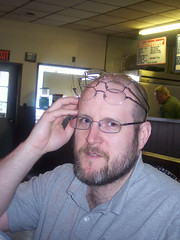Voting Machines and Trust
I was asked today why, if I so distrust the Diebold voting machines, I still use ATMs (many of which are manufactured by Diebold). "If Diebold can't be trusted," so the spurious argument went, "then why do you trust them with your money?"
The answer is simple: verifiability.
If anyone, from the maker of the ATM I'm using to its owner or even my own bank were to take even a penny more from my account than I authorized, I would catch it the next time I balanced my books. I have a paper trail which I can follow and verify that everything that happens in my account exactly matches what happened at the ATM.
The problem with the voting machines is that there is no such record. There is no receipt for the voter to indicate "You just withdrew one vote for Candidate X, your remaining balance is zero votes" or whatever. There's no independently created paper receipt which could be used for recounts. There is simply a number that comes out of the main computer, and we have only Diebold's word (or one of the few other voting machine manufacturers) that the number is at all accurate. Plus we KNOW that Diebold's machines, at least, are hackable in several ways, without leaving a trace.
I've mentioned before that just after the election, Howard Dean was shown on a PBS show how the results on the Diebold central tabulator machine could be changed using Microsoft Access to open the votes database, such that the software never knew anything funny had gone on, and it can be done in about 30 seconds.
I think I've also mentioned that a test of the machines recently showed that the cards on which votes are stored can be "pre loaded" with counts, even negative counts, but be tricked into reporting that they've been zeroed out. The machine certifies that the results are honest, but meanwhile the machines started out with extra votes for one party and a negative count for the other.
The fact is, electronic voting is not, by itself, a bad thing. But there needs to be a way to verify the results. Each voting machine should print out a receipt for the voter. The voter then verifies that his or her receipt shows the correct votes and places it in a ballot collector.
Then you have double certified election results. The electronic results are tabulated immediately and can give us relatively instant access to results, the paper ballots are counted separately in order to verify. And the printed receipts would be clear and unambiguous. No more "hanging chads" or ambiguous marks on the ballot making it difficult to determine who was voted for.
One of my friends, when I suggested this scheme, said "That would be way too expensive, having to double count every election." To which I say "Really? Just how expensive is too expensive to ensure fairness in the single most important part of our governance? How much do we spend going to other countries and helping to certify their election results? How stupid is it that we'll spend that kind of effort making sure a fledgling democracy has no voting irregularities, and then completely ignore our own?"
The problem with electronic voting machines is the same as the problem with the Unitary Executive having the power to do things merely because he says "trust me": there's no verification. And when you can't verify the results, you're just asking to be cheated.
Liam.



0 Comments:
Post a Comment
<< Home